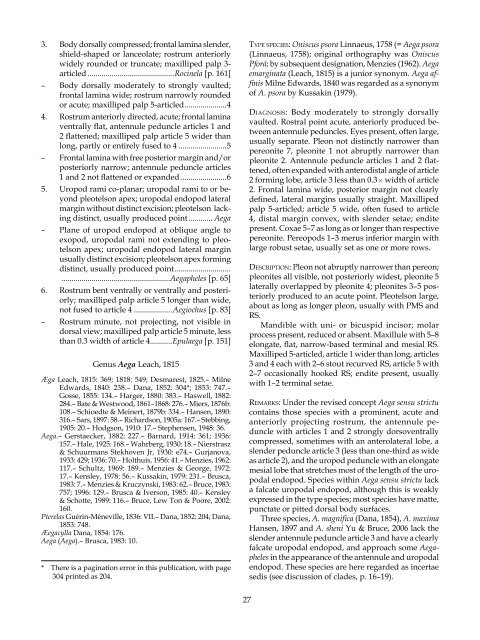The Marine Fauna of New Zealand: Isopoda, Aegidae (Crustacea)
The Marine Fauna of New Zealand: Isopoda, Aegidae (Crustacea)
The Marine Fauna of New Zealand: Isopoda, Aegidae (Crustacea)
You also want an ePaper? Increase the reach of your titles
YUMPU automatically turns print PDFs into web optimized ePapers that Google loves.
3. Body dorsally compressed; frontal lamina slender,<br />
shield-shaped or lanceolate; rostrum anteriorly<br />
widely rounded or truncate; maxilliped palp 3articled<br />
...........................................Rocinela [p. 6 ]<br />
– Body dorsally moderately to strongly vaulted;<br />
frontal lamina wide; rostrum narrowly rounded<br />
or acute; maxilliped palp 5-articled .....................4<br />
4. Rostrum anteriorly directed, acute; frontal lamina<br />
ventrally flat, antennule peduncle articles 1 and<br />
2 flattened; maxilliped palp article 5 wider than<br />
long, partly or entirely fused to 4 ........................5<br />
– Frontal lamina with free posterior margin and/or<br />
posteriorly narrow; antennule peduncle articles<br />
1 and 2 not flattened or expanded .......................6<br />
5. Uropod rami co-planar; uropodal rami to or beyond<br />
pleotelson apex; uropodal endopod lateral<br />
margin without distinct excision; pleotelson lacking<br />
distinct, usually produced point ............ Aega<br />
– Plane <strong>of</strong> uropod endopod at oblique angle to<br />
exopod, uropodal rami not extending to pleotelson<br />
apex; uropodal endopod lateral margin<br />
usually distinct excision; pleotelson apex forming<br />
distinct, usually produced point ............................<br />
......................................................Aegapheles [p. 65]<br />
6. Rostrum bent ventrally or ventrally and posteriorly;<br />
maxilliped palp article 5 longer than wide,<br />
not fused to article 4 ...................Aegiochus [p. 83]<br />
– Rostrum minute, not projecting, not visible in<br />
dorsal view; maxilliped palp article 5 minute, less<br />
than 0.3 width <strong>of</strong> article 4...........Epulaega [p. 5 ]<br />
Genus Aega Leach, 8 5<br />
Æga Leach, 8 5: 369; 8 8: 549; Desmarest, 825.– Milne<br />
Edwards, 840: 238.– Dana, 852: 304*; 853: 747.–<br />
Gosse, 855: 34.– Harger, 880: 383.– Haswell, 882:<br />
284.– Bate & Westwood, 86 – 868: 276.– Miers, 876b:<br />
08.– Schioedte & Meinert, 879b: 334.– Hansen, 890:<br />
3 6.– Sars, 897: 58.– Richardson, 905a: 67.– Stebbing,<br />
905: 20.– Hodgson, 9 0: 7.– Stephensen, 948: 36.<br />
Aega.– Gerstaecker, 882: 227.– Barnard, 9 4: 36 ; 936:<br />
57.– Hale, 925: 68.– Wahrberg, 930: 8.– Nierstrasz<br />
& Schuurmans Stekhoven Jr, 930: e74.– Gurjanova,<br />
933: 429; 936: 70.– Holthuis, 956: 4 .– Menzies, 962:<br />
7.– Schultz, 969: 89.– Menzies & George, 972:<br />
7.– Kensley, 978: 56.– Kussakin, 979: 23 .– Brusca,<br />
983: 7.– Menzies & Kruczynski, 983: 62.– Bruce, 983:<br />
757; 996: 29.– Brusca & Iverson, 985: 40.– Kensley<br />
& Schotte, 989: 6.– Bruce, Lew Ton & Poore, 2002:<br />
60.<br />
Pterelas Guérin-Méneville, 836: VII.– Dana, 852: 204; Dana,<br />
853: 748.<br />
Æegacylla Dana, 854: 76.<br />
Aega (Aega).– Brusca, 983: 0.<br />
* <strong>The</strong>re is a pagination error in this publication, with page<br />
304 printed as 204.<br />
27<br />
type speCies: Oniscus psora Linnaeus, 758 (= Aega psora<br />
(Linnaeus, 758); original orthography was Oniscus<br />
Pforá; by subsequent designation, Menzies ( 962). Aega<br />
emarginata (Leach, 8 5) is a junior synonym. Aega affinis<br />
Milne Edwards, 840 was regarded as a synonym<br />
<strong>of</strong> A. psora by Kussakin ( 979).<br />
diagnosis: Body moderately to strongly dorsally<br />
vaulted. Rostral point acute, anteriorly produced between<br />
antennule peduncles. Eyes present, <strong>of</strong>ten large,<br />
usually separate. Pleon not distinctly narrower than<br />
pereonite 7, pleonite not abruptly narrower than<br />
pleonite 2. Antennule peduncle articles 1 and 2 flattened,<br />
<strong>of</strong>ten expanded with anterodistal angle <strong>of</strong> article<br />
2 forming lobe, article 3 less than 0.3 H width <strong>of</strong> article<br />
2. Frontal lamina wide, posterior margin not clearly<br />
defined, lateral margins usually straight. Maxilliped<br />
palp 5-articled; article 5 wide, <strong>of</strong>ten fused to article<br />
4, distal margin convex, with slender setae; endite<br />
present. Coxae 5–7 as long as or longer than respective<br />
pereonite. Pereopods –3 merus inferior margin with<br />
large robust setae, usually set as one or more rows.<br />
desCription: Pleon not abruptly narrower than pereon;<br />
pleonites all visible, not posteriorly widest, pleonite 5<br />
laterally overlapped by pleonite 4; pleonites 3–5 posteriorly<br />
produced to an acute point. Pleotelson large,<br />
about as long as longer pleon, usually with PMS and<br />
RS.<br />
Mandible with uni- or bicuspid incisor; molar<br />
process present, reduced or absent. Maxillule with 5–8<br />
elongate, flat, narrow-based terminal and mesial RS.<br />
Maxilliped 5-articled, article wider than long, articles<br />
3 and 4 each with 2–6 stout recurved RS, article 5 with<br />
2–7 occasionally hooked RS; endite present, usually<br />
with –2 terminal setae.<br />
remarks: Under the revised concept Aega sensu strictu<br />
contains those species with a prominent, acute and<br />
anteriorly projecting rostrum, the antennule peduncle<br />
with articles and 2 strongly dorsoventrally<br />
compressed, sometimes with an anterolateral lobe, a<br />
slender peduncle article 3 (less than one-third as wide<br />
as article 2), and the uropod peduncle with an elongate<br />
mesial lobe that stretches most <strong>of</strong> the length <strong>of</strong> the uropodal<br />
endopod. Species within Aega sensu strictu lack<br />
a falcate uropodal endopod, although this is weakly<br />
expressed in the type species; most species have matte,<br />
punctate or pitted dorsal body surfaces.<br />
Three species, A. magnifica (Dana, 854), A. maxima<br />
Hansen, 897 and A. sheni yu & Bruce, 2006 lack the<br />
slender antennule peduncle article 3 and have a clearly<br />
falcate uropodal endopod, and approach some Aegapheles<br />
in the appearance <strong>of</strong> the antennule and uropodal<br />
endopod. <strong>The</strong>se species are here regarded as incertae<br />
sedis (see discussion <strong>of</strong> clades, p. 6– 9).

















